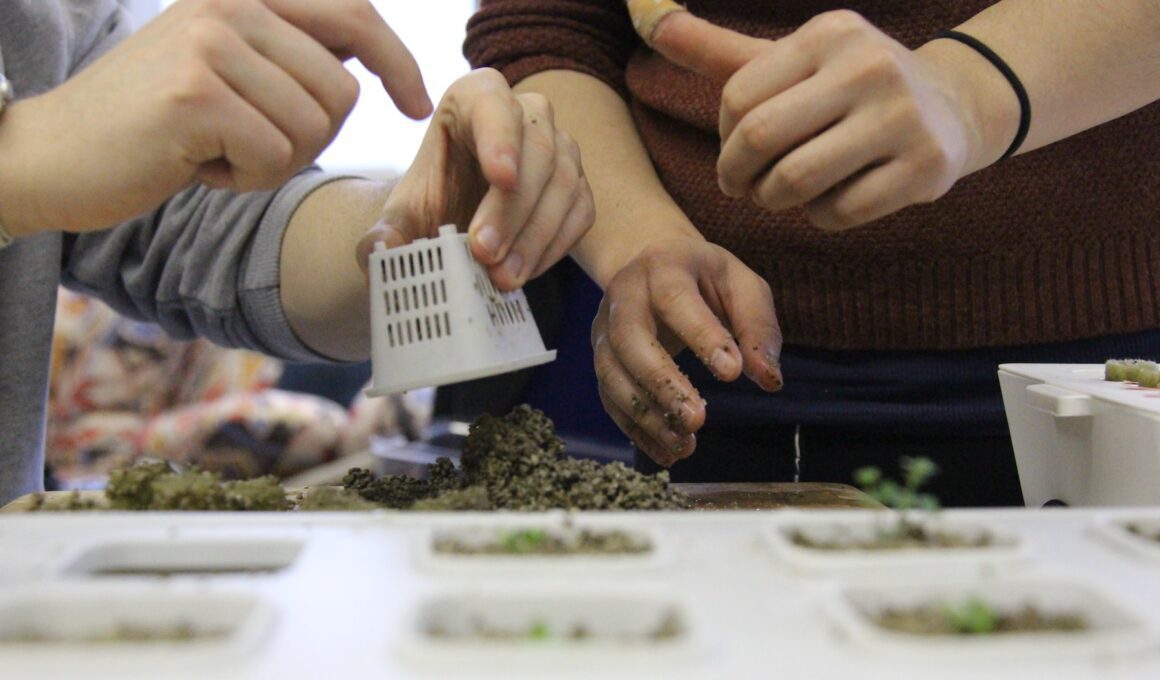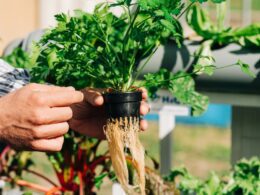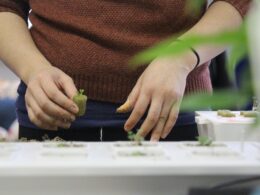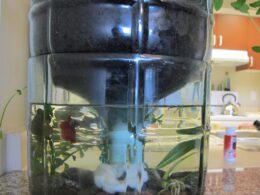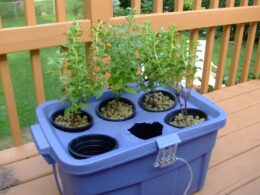If you’re interested in hydroponic vegetable gardening, you’re not alone. Many people are drawn to this method of growing produce because it’s efficient, eco-friendly, and can be done indoors.
But with so many different vegetables to choose from, it can be challenging to know which one is the best for your setup. Luckily, we’re here to help you navigate the options and choose the perfect vegetable for your hydroponic garden.
One of the primary benefits of hydroponic gardening is that it allows you to control all aspects of the plant’s environment, including light, nutrients, and water. This means that you can grow vegetables year-round, regardless of the weather outside. Additionally, hydroponics uses less water than traditional soil-based gardening, making it a more sustainable option.
But to get the most out of your hydroponic garden, it’s crucial to choose the right vegetables. In the following sections, we’ll discuss the factors you should consider when selecting hydroponic vegetables and highlight some of the top options.
With this information, you’ll be well on your way to a thriving hydroponic garden.
Benefits of Hydroponic Vegetable Gardening
If you’re looking for a low-maintenance and space-saving way to grow your own fresh produce, hydroponic gardening might be the perfect solution for you!
One of the biggest benefits of hydroponic vegetable gardening is the ability to grow plants vertically, which saves space and allows you to grow more plants in a smaller area. This is especially useful if you live in a small apartment or have limited outdoor space.
Another benefit of hydroponic vegetable gardening is the nutrient solution that the plants grow in. This solution provides all of the necessary nutrients that the plants need to grow, so you don’t have to worry about adding fertilizers or other supplements.
This also means that the plants are less likely to be affected by pests or diseases, since they are not exposed to soil-borne pathogens.
Overall, hydroponic vegetable gardening is a great way to grow your own fresh produce without the hassle of traditional gardening methods. Not only is it low-maintenance and space-saving, but the nutrient solution benefits also make it a safer and more efficient way to grow plants.
So why not give hydroponic gardening a try and see the benefits for yourself?
Factors to Consider When Choosing Hydroponic Vegetables
When selecting crops for a hydroponic system, it’s important to consider factors such as plant size, growth rate, and nutrient requirements. These factors can greatly affect the overall success of your hydroponic garden.
Here are three key factors to keep in mind when choosing hydroponic vegetables:
-
pH level: Different vegetables have different pH requirements. For example, lettuce prefers a pH range of 5.5-6.5, while tomatoes prefer a pH range of 6.0-6.5. It’s important to understand the pH requirements of your chosen vegetables and adjust the pH of your nutrient solution accordingly.
-
Nutrient requirements: Each vegetable has specific nutrient requirements, and it’s important to ensure that these requirements are met in your nutrient solution. For example, spinach requires high levels of nitrogen, while tomatoes require high levels of potassium. Make sure to do your research and provide the right nutrients for your chosen vegetables.
-
Growth rate: Some vegetables grow faster than others, and this can affect the overall yield of your hydroponic garden. For example, lettuce grows quickly and can be harvested in as little as 30 days, while tomatoes take longer to mature. Consider the growth rate of your chosen vegetables and plan your garden accordingly.
By considering these factors, you can choose the best vegetables for your hydroponic system and ensure a successful harvest. Remember to keep an eye on your pH levels and nutrient requirements, and adjust as necessary.
With a little bit of research and planning, you can enjoy fresh, healthy vegetables all year round.
Is the White Stuff Floating in My Hydroponics System Harmful to the Vegetables?
The presence of white stuff in hydroponics may seem concerning, but fear not! This phenomenon is usually harmless to your precious vegetables. The white substance often observed is most likely the result of mineral deposits or fungal growth. Regularly monitoring and maintaining proper nutrient levels, pH balance, and cleanliness in your hydroponics system can effectively prevent any potential harm to your thriving plants.
Top Hydroponic Vegetables
You’ll love discovering the top veggies to grow in your hydroponic system! When it comes to choosing vegetables for your hydroponic garden, it’s important to consider their nutritional value and growth rate.
Here are some of the top hydroponic vegetables that you should consider growing:
First on the list is lettuce, which is a perfect choice for beginners due to its fast growth rate. It only takes about 4-6 weeks for lettuce to mature in a hydroponic system. Additionally, lettuce is packed with nutrients like vitamin A, K, and folate, making it a great addition to any meal.
Another great vegetable to grow hydroponically is spinach. Like lettuce, spinach has a fast growth rate and can be harvested in just 4-6 weeks. It’s also packed with nutrients such as iron, magnesium, and vitamin C, making it an excellent choice for maintaining a healthy diet.
Lastly, herbs like basil, cilantro, and parsley are also great for hydroponic systems. They have a relatively fast growth rate and are packed with flavor and nutritional value. Additionally, herbs can be grown year-round in a hydroponic system, making them a convenient and versatile addition to any meal.
So, there you have it – the top hydroponic vegetables to consider growing in your system. With their fast growth rate and nutritional value, these veggies are sure to make a great addition to your diet.
Tips for Successful Hydroponic Vegetable Gardening
Ready to take your hydroponic vegetable garden to the next level? To ensure successful gardening, pH management is crucial. The ideal pH level for hydroponic vegetable gardening is between 5.5 to 6.5.
Maintaining the pH level within this range will help your plants absorb the necessary nutrients for optimal growth. In addition to pH management, nutrient solution plays a vital role in hydroponic vegetable gardening.
Make sure to use a high-quality nutrient solution that contains all the essential minerals and nutrients your plants need. It’s also important to monitor the nutrient solution’s strength regularly, as over-fertilization can damage your plants.
Lastly, ensure that your hydroponic vegetable garden receives sufficient light, as this plays a significant role in your plant’s growth and development. If you’re growing indoors, consider investing in high-quality grow lights that provide the necessary light spectrum to promote healthy growth.
With these tips and a little bit of patience and perseverance, you’ll be on your way to a thriving hydroponic vegetable garden in no time.
Conclusion: Choosing the Right Hydroponic Vegetable for You
Discover your perfect hydroponic vegetable match and start growing your own fresh, flavorful produce that will have you feeling accomplished and satisfied. Hydroponic gardening has many advantages over traditional soil gardening, such as being able to control the nutrients and water your plants receive. Plus, it’s perfect for those with limited space, as hydroponic systems can be set up in small areas like a balcony or countertop.
When it comes to choosing the right vegetable for your hydroponic garden, there are many options to consider. Leafy greens like lettuce, spinach, and kale are great choices as they grow quickly and take up minimal space. Tomatoes and peppers are also popular options, providing a delicious crop that can be harvested multiple times throughout the growing season. Whatever vegetable you choose, make sure to do your research and find the best variety for your hydroponic system.
In conclusion, hydroponic gardening is a great way to grow fresh, healthy produce in small spaces. By choosing the right vegetable for your hydroponic system, you can enjoy a bountiful harvest all year round. Whether you’re a beginner or an experienced gardener, hydroponics offers a fun and rewarding way to grow your own food. So, start exploring the possibilities and find your perfect hydroponic vegetable match today!
Frequently Asked Questions
What are the different types of hydroponic systems available for vegetable gardening?
If you’re looking to start hydroponic vegetable gardening, there are two main types of systems you should consider: vertical systems and nutrient film systems.
Vertical systems are great for small spaces because they allow you to grow plants upward, rather than outward.
Nutrient film systems, on the other hand, are perfect for larger crops like lettuce and herbs. In this type of system, nutrient-rich water is constantly circulated over the roots of the plants, providing them with the nutrients they need to grow.
Both of these systems are perfect for growing vegetables hydroponically, and can be a great way to get started with this type of gardening.
How does hydroponic vegetable gardening compare to traditional soil gardening in terms of yield and quality?
If you want to maximize your yield and nutrient management, hydroponic vegetable gardening may be the way to go. Compared to traditional soil gardening, hydroponics can produce higher yields in a smaller space and with less water. This is because hydroponic systems provide a more controlled environment where plants receive a precise amount of nutrients and water.
In traditional soil gardening, nutrient levels can vary greatly depending on soil quality and other factors. Additionally, hydroponic systems are less prone to pests and diseases, meaning you can avoid the use of harmful pesticides and chemicals.
Overall, hydroponic gardening can offer a safer and more efficient way to grow vegetables.
What are the common challenges and problems faced by hydroponic vegetable gardeners, and how can they be overcome?
Overcoming challenges in hydroponic vegetable gardening can seem daunting, but with a few tips for success, you can have a thriving garden in no time.
One common problem is nutrient deficiencies, which can be addressed by regularly checking and adjusting nutrient levels.
Another challenge is pest control, but this can be overcome by using natural predators or organic methods.
Temperature and humidity control can also be a challenge, but investing in a good climate control system can help.
Remember to regularly monitor and maintain your hydroponic system to ensure its success.
Are there any specific nutrients or supplements that are essential for hydroponic vegetable growth and health?
To achieve optimal growth and health in hydroponic vegetable gardening, it’s essential to provide the right nutrient solutions and maintain proper pH balance. Nutrient solutions provide plants with the necessary minerals and elements they need to thrive, while pH balance ensures that the plants can absorb these nutrients efficiently.
When considering larger scale implementation of hydroponic vegetable gardening, cost efficiency and scalability must be taken into account. By focusing on essential components and considerations, hydroponic gardening can be an effective and safe way to grow healthy vegetables.
How can hydroponic vegetable gardening be made more environmentally friendly and sustainable?
If you’re looking to make your hydroponic vegetable gardening more environmentally friendly and sustainable, there are a few things you can do.
Firstly, consider composting your organic waste. Not only does this reduce the amount of waste going into landfills, but it also creates a nutrient-rich fertilizer for your plants.
Secondly, try to reduce your water usage by recycling and reusing water as much as possible. This not only saves water, but it also reduces the amount of nutrients and fertilizers that are lost through runoff.
By taking these steps, you can make your hydroponic vegetable gardening more sustainable and help protect the environment for future generations.
Conclusion
So there you have it, the benefits of hydroponic gardening are clear and choosing the right vegetable is crucial for success.
Remember to consider factors such as space, lighting, and temperature when selecting your plants.
If you’re just starting out, it’s best to stick with easy-to-grow vegetables such as lettuce, spinach, and herbs. With a bit of practice and experimentation, you can move on to more challenging crops like tomatoes and peppers.
By following these tips and putting in the effort, you can enjoy fresh, healthy vegetables all year round with hydroponic gardening. Happy growing!





